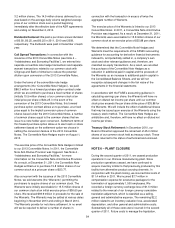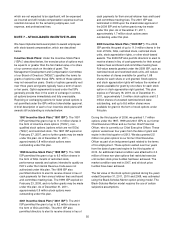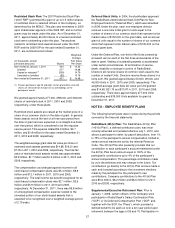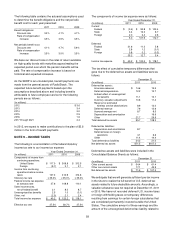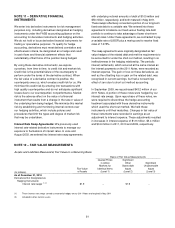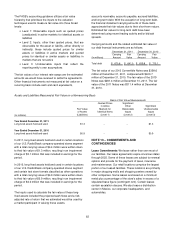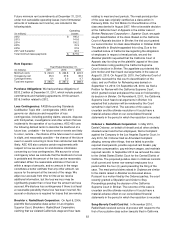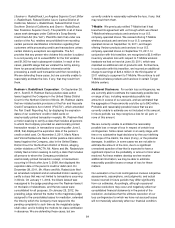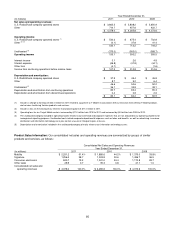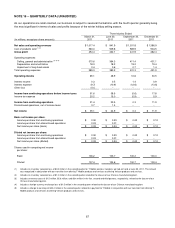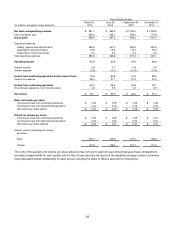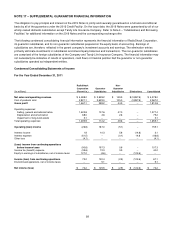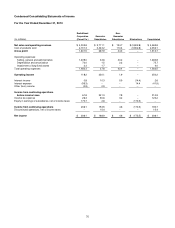Radio Shack 2011 Annual Report Download - page 70
Download and view the complete annual report
Please find page 70 of the 2011 Radio Shack annual report below. You can navigate through the pages in the report by either clicking on the pages listed below, or by using the keyword search tool below to find specific information within the annual report.
62
The FASB’s accounting guidance utilizes a fair value
hierarchy that prioritizes the inputs to the valuation
techniques used to measure fair value into three broad
levels:
• Level 1: Observable inputs such as quoted prices
(unadjusted) in active markets for identical assets or
liabilities
• Level 2: Inputs, other than quoted prices, that are
observable for the asset or liability, either directly or
indirectly; these include quoted prices for similar
assets or liabilities in active markets and quoted
prices for identical or similar assets or liabilities in
markets that are not active
• Level 3: Unobservable inputs that reflect the
reporting entity’s own assumptions
The fair values of our interest rate swaps are the estimated
amounts we would have received to settle the agreements.
Other financial instruments not measured at fair value on a
recurring basis include cash and cash equivalents,
accounts receivable, accounts payable, accrued liabilities,
and long-term debt. With the exception of long-term debt,
the financial statement carrying amounts of these items
approximate their fair values due to their short-term nature.
Estimated fair values for long-term debt have been
determined using recent trading activity and/or bid/ask
spreads.
Carrying amounts and the related estimated fair value of
our debt financial instruments are as follows:
December 31, 2011
December 31, 2010
(In millions)
Carrying
Amount
Fair
Value
Carrying
Amount
Fair
Value
Total debt $ 670.6 $ 641.0
$ 639.8 $ 713.1
The fair value of our 2013 Convertible Notes was $358.6
million at December 31, 2011, compared with $400.7
million at December 31, 2010. The fair value of the 2019
Notes was $281.4 million at December 31, 2011. The fair
value of the 2011 Notes was $311.4 million at December
31, 2010.
Assets and Liabilities Measured at Fair Value on a Nonrecurring Basis
Basis of Fair Value Measurements
Fair Value
of Assets
(Liabilities)
Quoted Prices
in Active
Markets for
Identical Items
(Level 1)
Significant
Other
Observable
Inputs
(Level 2)
Significant
Unobservable
Inputs
(Level 3)
(In millions)
Year Ended December 31, 2011
Long-lived assets held and used $1.3 -- -- $1.3
Year Ended December 31, 2010
Long-lived assets held and used $0.9 -- -- $0.9
In 2011, long-lived assets held and used in certain locations
of our U.S. RadioShack company-operated stores segment
with a total carrying value of $4.4 million were written down
to their fair value of $1.3 million, resulting in an impairment
charge of $3.1 million that was included in earnings for the
period.
In 2010, long-lived assets held and used in certain locations
of our U.S. RadioShack company-operated stores segment
and certain test store formats classified as other operations
with a total carrying value of $4.9 million were written down
to their fair value of $0.9 million, resulting in an impairment
charge of $4.0 million that was included in earnings for the
period.
The inputs used to calculate the fair value of these long-
lived assets included the projected cash flows and a risk-
adjusted rate of return that we estimated would be used by
a market participant in valuing these assets.
NOTE 13 – COMMITMENTS AND
CONTINGENCIES
Lease Commitments: We lease rather than own most of
our facilities. Our lease agreements expire at various dates
through 2025. Some of these leases are subject to renewal
options and provide for the payment of taxes, insurance
and maintenance. Our retail locations comprise the largest
portion of our leased facilities. These locations are primarily
in major shopping malls and shopping centers owned by
other companies. Some leases are based on a minimum
rental plus a percentage of the store's sales in excess of a
stipulated base figure (contingent rent). Certain leases
contain escalation clauses. We also lease a distribution
center in Mexico, our corporate headquarters, and
automobiles.




